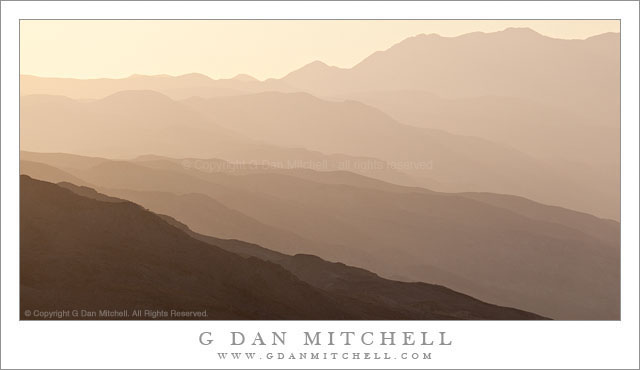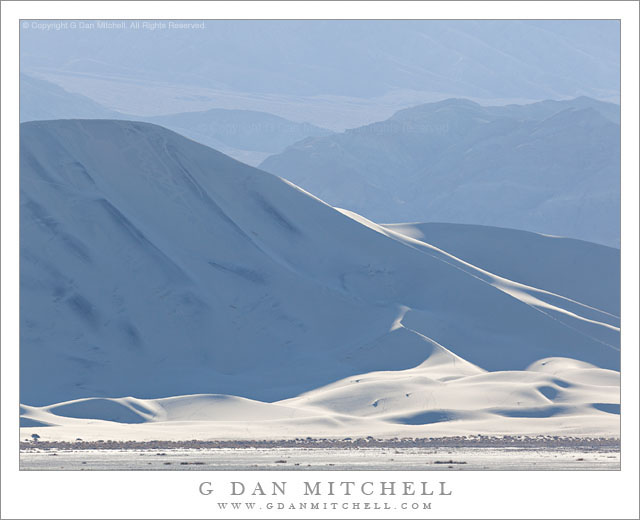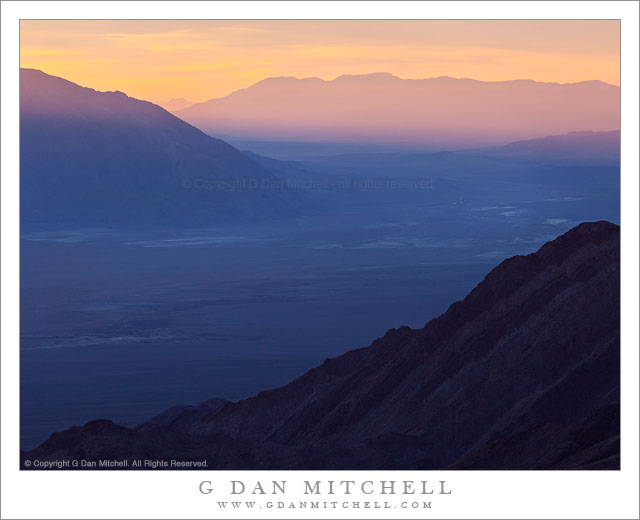Ridges and Haze. Death Valley National Park, California. January 3, 2012. © Copyright 2012 G Dan Mitchell – all rights reserved.
Morning haze and receding ridges above Death Valley.
There is “stuff” to photograph virtually anywhere you go in Death Valley – from the popular, iconic locations to the furthest back-country areas to nondescript turn-outs along whatever road you happen to be on. One of my goals on this January 2012 trip was to shoot some less-obvious locations. While the image is perhaps not “less obvious,” the location is probably not anything you are going to find in your park guidebook.
Early one morning I was out and about, at least partly thinking about where not to shoot – not the obvious places that first come to mind on a Death Valley morning. (I have nothing at all against photographing those places, too, especially when the conditions are just right.) I ended up more or less randomly heading up a road into some mountains, but without a specific goal in mind. I was simply driving along and watching for the “right” conduction of form and light and color. Several times I thought I saw something, but I didn’t stop, instead just making a quick mental note that I might want to come back to these spots and shoot them. (I didn’t on this trip, but I have them filed away for a future visit.) I finally arrived at a junction where the light was good, got out, set up camera and tripod, and set about looking for subjects.
Sometimes I have a pretty good idea of what I’m looking for, but it might surprise some people that I occasionally – perhaps more than you might think – have no specific photographic objective in mind when I get out the gear and begin my “hunt.” I like to joke that I could find myself almost anywhere with a camera and tripod and eventually find something to shoot within 50 feet of my location. (Occasionally, it might even be a good photograph… :-) While I most certainly do like certain locations, in many cases it isn’t so much about the specific place as it is about hunting for and discovering the visual opportunities presented by whatever place I’m in.
So, I started looking around. And I started making photographs. I photographed a nearby hill that caught some “first light” from the east, with more distant hills in the background. I photographed a long view of a haze-filled valley scene. I pointed my camera up a gully filled with rocks and desert plants. I make a picture of a non-description ridge top pinnacle with interesting clouds behind it. And I put the longest lens I had on the camera and shot almost into the sun to photograph this amazing sequence of stacked ridges high along the spine of a nearby mountain range.
G Dan Mitchell is a California photographer whose subjects include the Pacific coast, redwood forests, central California oak/grasslands, the Sierra Nevada, California deserts, urban landscapes, night photography, and more.
Blog | About | Flickr | Twitter | Facebook | Google+ | 500px.com | LinkedIn | Email
Text, photographs, and other media are © Copyright G Dan Mitchell (or others when indicated) and are not in the public domain and may not be used on websites, blogs, or in other media without advance permission from G Dan Mitchell.




